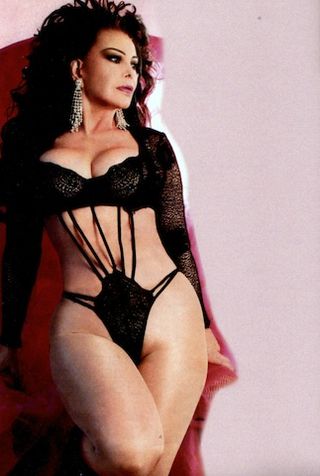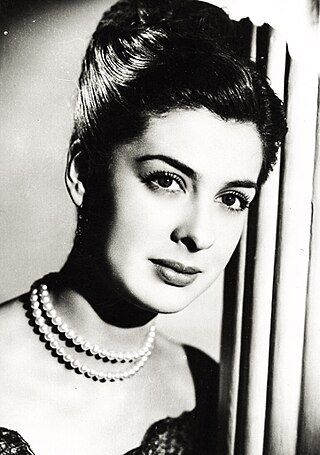
Maria Antonieta Pons was a Cuban-born Mexican film actress and dancer. She was the first actress in the Rumberas films in the 1940s and 1950s, in the Golden Age of Mexican cinema. The Rumberas film genre offered a societal perspective on Mexico during the 40s-50s. It delved into the lives of women deemed as sinners or prostitutes, challenging the prevailing moral and social norms of their era.

Lorena Velázquez was a Mexican actress and beauty pageant titleholder. At the time of her death she was one of the last surviving stars from the Golden Age of Mexican Cinema.

Isela Vega Durazo was a Mexican actress, singer-songwriter, and filmmaker.

Amalia Isabel Rodríguez Carriera, known professionally as Amalia Aguilar, was a Cuban-Mexican dancer, actress and comedian.

Rosa Carmina Riverón Jiménez is a Cuban-Mexican actress and dancer.

Emelia Pérez Castellanos, known professionally as Ninón Sevilla, was a Cuban-Mexican actress and dancer.
Su Muy Key was a Mexican vedette, film actress and dancer of Chinese descent. She was one of the first Burlesque performers in México. She was nicknamed "Muñequita China".
Juan Rogelio García García, better known as Juan Orol, was a Spanish-born Mexican actor, film producer, director and screenwriter. Orol was a pioneer of the Mexican cinema's first talkies and one of the main promoters of the Rumberas film in the Golden Age of Mexican cinema. His films have been described as cult films.
The Rumberas film was a film genre that flourished in Mexico's Golden Age of Mexican cinema in the 1940s and 1950s. Its major stars were the so-called rumberas, dancers of Afro-Caribbean musical rhythms. The genre is a film curiosity, one of the most fascinating hybrids of the international cinema.

María del Pilar Pellicer López de Llergo was a Mexican actress. At the 17th Ariel Awards, she won the Ariel Award for Best Actress for her performance in the film La Choca (1974).

Ana Luisa Peluffo is a Mexican actress. She has appeared in more than 200 films and television shows since 1949. She starred in the 1977 film Paper Flowers, which was entered into the 28th Berlin International Film Festival.
A vedette is the main female artist of a show derived from cabaret and its subcategories of revue, vaudeville, music hall or burlesque. The purpose of the vedette is to entertain and captivate the public. Vedettes are expected to sing, dance and act on stage. Particularly accomplished artistes are considered super vedettes or first vedettes. Vedettes often appear alongside groups of dancers, flashy and revealing costumes, magicians, comedians, jugglers, or even performing animals. Vedettes specializing in burlesque generally do striptease and may also perform nude on stage.

María del Rosario Mendoza Chávez was a Mexican vedette, actress, dancer, and singer. During the 1970s–1980s, she was one of the highest grossing artists in the Mexican sex comedy film genre.
Sandra, la mujer de fuego is a Mexican-Cuban drama film directed by Juan Orol. It was released in 1954 and starring Rosa Carmina and Arturo Martínez.
Juana Amanda Seux Ramírez, better known as Wanda Seux, was a Paraguayan-Mexican vedette, dancer, and actress, who enjoyed a long career in film, television, and theatre in Mexico.

Rebeca de Iturbide Betancourt (1924–2003) was a Mexican-American actress of the Golden Age of Mexican cinema, who was known for her versatility, being able to play comedy or drama. She was a pioneer in television, playing roles in the mid-1950s. In addition to acting, she also wrote and painted.
David Silva Guglielmeti was a Mexican actor and occasional producer of the Golden Age of Mexican cinema. In his career, he appeared in more than 100 films and won an Ariel Award for his leading role in the film Champion Without a Crown (1946).
Thelma Delia Suklenik Snopik, better known by her stage name Thelma Tixou, was a Mexican vedette and actress of Argentine origin. She was one of the most popular Mexican vedettes during the 1970s and 1980s, and she became famous worldwide for her role as The Tattooed Woman in Alejandro Jodorowsky's cult classic film Santa Sangre (1989).
Susan Linda Fair, better known as Princesa Lea is a Canadian-born Mexican vedette, actress, and dancer, of Canadian origin. She was one of the most popular Mexican vedettes during the 1970s and 1980s.

The Fantastic World of Juan Orol is a 2012 Mexican black-and-white biographical comedy-drama film directed by Sebastián del Amo and written by Del Amo & Raúl Fernández Espinosa. Starring Roberto Sosa. It was named on the shortlist for Mexico's entry for the Academy Award for Best Foreign Language Film at the 85th Academy Awards, but it was not selected.














